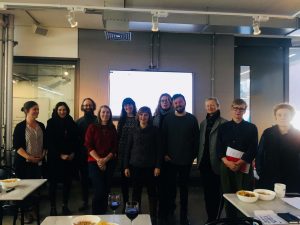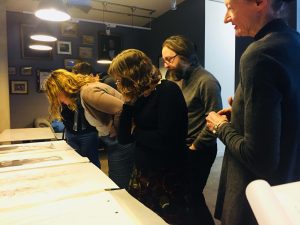For the second year running, Griffin Gallery hosted an Engine ChatChat residency exclusively for UAL’s Postgraduate Community.
By Naira Mushtaq, PG Community Ambassador for Central Saint Martins studying MA Fine Art.
These sessions were mediated by artist Elizabeth Murton and hosted by Griffin Gallery, against the backdrop of Godley House, a site responsive show that was both informal and stimulating, with constructive conversation encouraged.
Bringing together a group of 8 artists from different stages of their practice under one roof. 7 of which were UAL students and alumni, creating an energetic mix of different disciplines from sculpture to film, painting and installation.
In each session, selected artists presented their work to rest of the group, followed by a discussion about their practice.
Griffin Gallery provided a safe space for the artists to share their work in a supportive environment as well as being honest and critical to each other’s practice. For some of the artists, these sessions proved to be a good instigator to encourage them to fall back into their practice after being out of institutional setting while the current students benefited from a different perspective than that offered on their courses, receiving valuable advice, support and encouragement.
Perhaps the most interesting element of these sessions was seeing the overlapping concerns in these variant practices, as best said by Elizabeth Murton during the closing notes of the sessions, who defines what art is, as artists are self-defining and they will always find expression in different ways.
Participating artists included:
Agnes Villette, a photographer and visual artist whose practice is research-based and multi-disciplinary. She explores photography, texts and sound to create installations that reflect upon ecological and political issues. Influenced by the theoretical writing generated by the Anthropocene and Dark Ecology, she develops projects that merge art and science. Informed by her career as a journalist, she connects Geiger counter data and interviews with the local population to create a visual discourse.
Carlos Sebastiá, currently doing his MFA at Wimbledon College of Arts, a multidisciplinary artist his practice revolves around the understanding of impermanence. His work explores the role of forgetting by deconstructing the complexity of reality he believes that from the naiveté, and through art, we are able to ‘fold’ pre-established concepts, bringing new perspectives from a sensory experience.
Having a broad range of practice from painting to installation, photographs play an integeral role in all of Carlos’ work. He is currently running a small residency project in Spain. You can follow him on Instagram @i.carlos_sebastia to keep up to date with his practice.
Frederic Anderson studied at Wimbledon College of Arts and his practice explores the variant possibilities of mark making in the space. Fredric uses a blind drawing technique as he works, and these gestural drawings are mostly charcoal, ink or graphite on paper. His finalised drawings resemble a space between figuration and abstraction fleeting yet familiar. You can follow his work on instagram: @Fredericandersondrawings
Jackie Castellano is a video artist and her work adopts an abstract approach that is concerned with surface, duration, focus and rhythm. Inhabiting a physical and psychological space, her work enables the viewer to project their own memories and experiences onto moving images.
Jane Pickersgill is soon to be a graduate of Wimbledon College of Arts, her practice is driven by deep curiosity in materials; how they can be pushed to the limit with or against their inherent properties and usage. The physical methodology is exploratory, highlighting experimentation and accident. The focus is on the in-between spaces; fragments of buildings and spaces, noting points of connection, intersections of object, event and experience she is intrigued by the mass, the line, the surface reflection and the changes in shadows; encountered daily, but largely unnoticed. Her work oscillates between 2D and 3D, an investigation into the politics of an urban-scape. Keep an eye on her Instagram @tatteredstones
Janine Hall’s ethereal charcoal drawings are highly deceptive, her practice revolves around researching and developing ideas about shadows, light and fleeting moments using graphite mostly and some of her work incorporates acrylic paint and ink. Janine enjoys taking a concept and transferring it into other materials. Chance, balance and play are a big part in the development of her work. Her stunning drawings induce a sense of calm in the viewer, you can find out more about her work on her website www.janinehall.co.uk.
Karen Tronel has a varied practice, her work includes paintings, sculptures and installation works which engage with the humorous, strange and absurd aspects of everyday objects, behaviors and verbal expressions, creating both shifted realities and an escape to an imagined and curious space and time. Her work uses satire and wit to talk about social issues.
Morna Hinton’s practice is poignant and nostalgic involving, paintings, prints and film. The urban landscape of London is a subject that dominates her current practice. An investigation into the contrast between fragile grasses and Brutalist architecture, the transformative effect of snow in a city park, or the rust eating into an abandoned boat on the Thames. Human traces are evident, but people are often absent or obscured in her work, reflecting a wider theme of loss. For her film projects, she often collaborates with composers to produce work that is leaves the viewer with a sense of longing, you can see her work on her website mornahinton.weebly.com
Nell Lynhe is currently exploring female representations in iconographic works particularly looking at the sheep, as for her, they embody a male presence and she wants to challenge this representation. She is currently doing her MA in Fine Art at Chelsea College of Arts.
Sam Hodge, unlike her other Engine Chat participants has a background in natural sciences and painting conservation, which she studied at Cambridge University and The Courtauld Institute of Art. While working as a painting conservator she also studied fine art.
Her practice is concerned with how things are made and how they fall apart. She makes paintings and prints exploring the role of chance and accident in these processes but is also interested in how we respond to chance events and tries to make sense of them; this amalgamation of art and science is reflective in her work which incorporates found objects that are ephemeral in nature to found objects. Sam’s upcoming exhibit is Surface Tension runs from 5th April-to 29th April at the stone space you can follow her on Instagram: @Samhodgeart
Join other UAL postgraduate students at a Pop Up Common Room.





